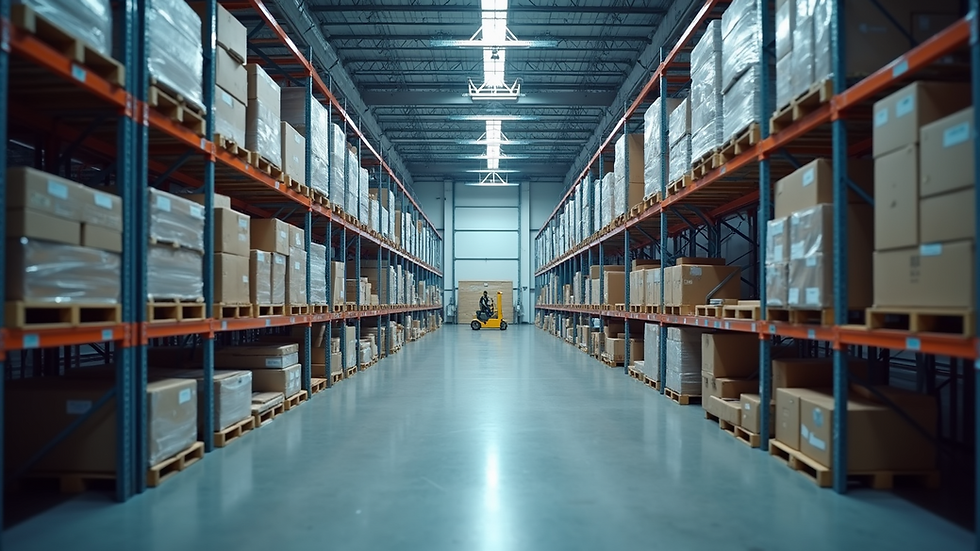How AI and Automation Are Transforming 3PL in Australia
- Nat Sandhu
- Aug 4
- 3 min read
The logistics sector is undergoing a significant transformation, thanks to advancements in technologies like Artificial Intelligence (AI) and automation. In Australia, these innovations are reshaping Third-Party Logistics (3PL) to meet the evolving needs of e-commerce businesses. With customers demanding faster delivery and greater accuracy, 3PL providers must adapt to stay competitive. Let's explore how AI and automation are improving operations and uncovering new growth opportunities in the Australian market.
The Rise of AI in Logistics

AI is revolutionizing logistics by enabling the analysis of large datasets. This empowers 3PL providers to make quicker, more informed decisions. For instance, Australian businesses are using AI for better inventory management and accurate demand forecasting. According to a recent study, companies that leverage AI for inventory optimization can reduce excess inventory by as much as 30%.
AI technology also enhances route planning in freight transportation. For example, companies like Linfox use AI to analyze traffic patterns and weather conditions to optimize their delivery routes. This results in reduced fuel costs and improved delivery times, crucial for an expansive country like Australia.
Automation in Warehouse Management
Warehouse automation is no longer optional; it's essential for efficiency. Automated systems, such as robotic pickers and conveyor belts, are transforming warehouse operations across Australia. Research shows that automating warehouse operations can reduce order fulfillment times by up to 50%.
With these technologies, 3PL providers can speed up processes like picking, packing, and shipping. Automation also minimizes human errors, allowing businesses to fulfill orders with high accuracy. For instance, an Australian e-commerce company that adopted robotic automation reported a 25% increase in productivity within six months.
Enhancing Customer Experience with AI
Customer experience is critical in today’s driven marketplace, and AI plays a vital role in enhancing it. AI-powered chatbots can provide instant customer support, handling queries about shipment statuses quickly. This real-time communication helps keep customers informed, which is essential for fostering loyalty.
Personalization is another significant advantage AI offers. For example, by analyzing customer purchase data, companies can predict what products might interest a customer, leading to customized solutions that meet their unique needs. Australian businesses harnessing AI for personalization have reported a 20% increase in customer satisfaction rates.
Real-Time Tracking and Transparency
In logistics, real-time tracking can significantly influence customer decisions. With the help of AI and automation, 3PL providers can offer advanced tracking solutions that keep customers updated on their shipments. A survey found that 94% of customers consider tracking capabilities essential for their purchasing decisions.
This transparency fosters trust and enhances customer satisfaction. For instance, businesses using AI-driven tracking systems can offer alerts about potential delays, allowing them to manage customer expectations effectively. This capability helps businesses not just satisfy customers but also react swiftly to any challenges.
Increased Efficiency through Integrated Systems
Integrating AI and automation leads to improved communication across various logistics processes. For example, when inventory management, order processing, and shipping systems work together seamlessly, lead times diminish, and overall efficiency increases.
In Australia’s complex supply chain, integration is crucial. Companies that implement integrated systems can improve operational flow, which is vital for staying agile. Managers can then devote their time to strategic decision-making instead of being absorbed in everyday tasks.
Challenges and Considerations
While the benefits of AI and automation are notable, it is important to acknowledge the challenges. One primary hurdle is the initial investment for technology implementation. Many Australian businesses may hesitate to commit funds due to budget constraints.
Moreover, staff training is necessary to ensure workers can effectively operate new technologies. As automation grows more common, companies must invest in upskilling their workforce.
Lastly, concerns about cybersecurity are relevant as businesses increasingly rely on automated systems. Establishing strong security measures is essential for protecting sensitive data and maintaining customer trust.
The Future of Logistics in Australia
AI and automation are transforming 3PL in Australia. These technologies offer exciting opportunities for improved efficiency, accuracy, and customer satisfaction. As e-commerce grows, harnessing advanced technologies in logistics becomes more vital.
By embracing AI and automation, Australian businesses can maintain a competitive edge. However, it is also crucial to confront and navigate potential challenges that may arise. The future of logistics, enhanced by these innovations, promises a streamlined, customer-focused experience crucial for success in today's market.

_edited.jpg)



Comments